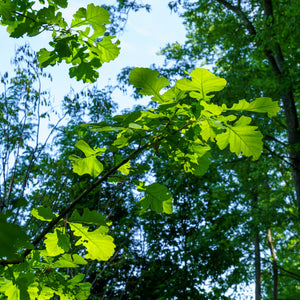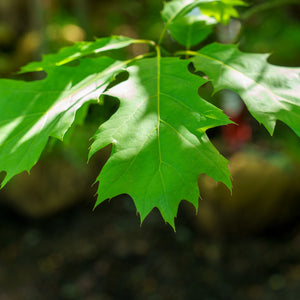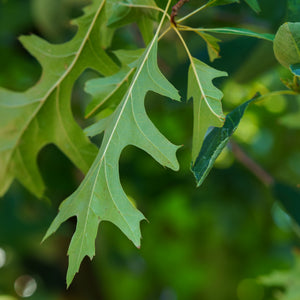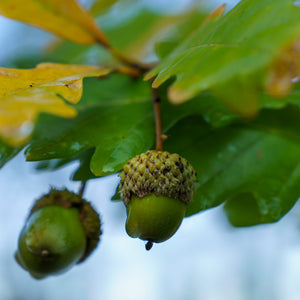The Oak Guide
Oak trees (Quercus spp.) are some of the most enduring and iconic hardwood trees in the world, renowned for their majestic stature, strength, and ecological importance. With hundreds of species distributed across the Northern Hemisphere, oaks are integral to both natural ecosystems and cultivated landscapes. Their lobed or toothed leaves, dense canopies, and long lifespans make them standout trees in parks, streetscapes, and large gardens.
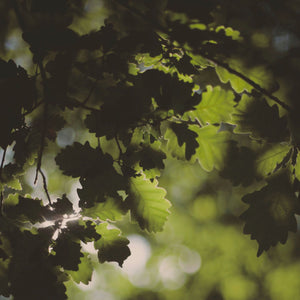
About
The genus Quercus includes both deciduous and evergreen species, divided into two main groups: red oaks and white oaks. Red oaks (such as Quercus rubra and Quercus coccinea) typically have pointed lobes and acorns that take two years to mature. White oaks (such as Quercus alba and Quercus bicolor) feature rounded lobes and acorns that mature in one season.
Oaks can vary widely in form and function:
- Quercus alba (White Oak) – A stately, broad-canopied tree known for longevity and fall color.
- Quercus rubra (Northern Red Oak) – A fast-growing red oak with deeply lobed leaves and a symmetrical form. The Northern Red Oak is the state tree of New Jersey, our home state.
- Quercus macrocarpa (Bur Oak) – Massive trunk and unique fringed acorns make it a centerpiece in open spaces.
- Quercus bicolor (Swamp White Oak) – Adaptable and tolerant of wet soils; excellent for large landscapes.
- Quercus palustris (Pin Oak) – Known for strong fall color and a pyramidal shape; widely planted as a street tree.
- Quercus phellos (Willow Oak) – Features narrow, willow-like leaves and thrives in urban conditions.
Hybrid and columnar cultivars, like Quercus robur 'Fastigiata' and Quercus x Kindred Spirit, offer narrower forms for tighter spaces, while Quercus shumardii and Quercus imbricaria serve well in large-scale plantings.
Oaks play a critical role in supporting biodiversity, serving as host plants to hundreds of caterpillar species and providing shelter and food for birds, mammals, and insects. Their longevity and resistance to storm damage also make them reliable shade trees.
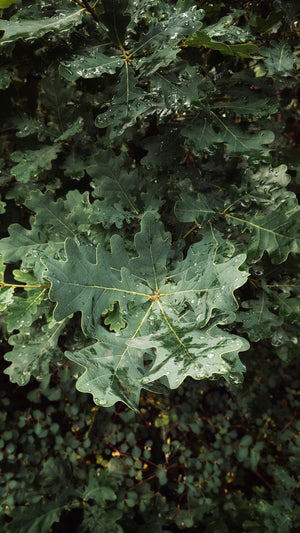
PLANTING
Oaks require a bit of patience but reward gardeners with decades—if not centuries—of beauty, structure, and environmental service.
USDA Hardiness Zones: Most oak species thrive in Zones 4–9, with some variation by species.
Soil: Well-drained, loamy soils are ideal, but many species adapt to clay, sand, and even periodically wet soils. Avoid planting in heavily compacted areas.
Sunlight: Full sun is best for optimal growth, canopy development, and acorn production. Oaks need a minimum of 6 hours of direct sunlight daily.
Watering: Moderate watering during establishment. Once established, most oaks are drought-tolerant, though young trees benefit from consistent moisture.
Spacing: Allow 30 to 60 feet between large oak trees depending on species and mature size. Columnar types can be planted more closely.
Planting Time: Early spring or fall is best. Bare-root or container-grown saplings should be planted when soil is workable and temperatures are mild.
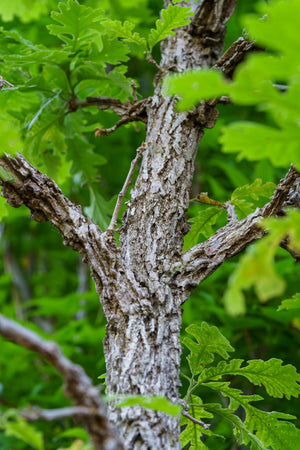
CARE
Watering: Water young trees deeply once a week during dry spells. Established trees typically need no supplemental watering except during severe drought.
Fertilizing: Oaks rarely require fertilizer. If growth is poor, apply a balanced, slow-release fertilizer in early spring.
Pruning: Prune in late winter to remove dead, diseased, or rubbing branches. Avoid pruning in spring and early summer to reduce the risk of oak wilt disease. Structural pruning in youth is essential for strong framework.
Pests and Diseases: Oaks are susceptible to oak wilt, anthracnose, and various boring insects. Selecting resistant species and proper pruning practices minimize risk. Mulch properly and avoid damaging roots.
Mulching: Mulch 2–4 inches deep around the base, extending to the dripline if possible. Keep mulch several inches away from the trunk.
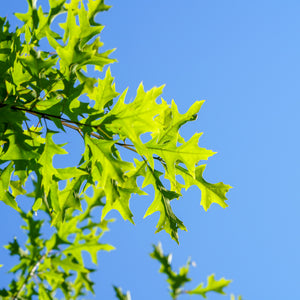
HOW TO USE
Focal Point: Oaks like Quercus alba and Quercus rubra make commanding focal points in parks, estates, or expansive lawns. Their massive canopies and stately forms become defining features of the landscape.
Street Trees: Columnar or upright cultivars such as ‘Regal Prince’ or ‘Kindred Spirit’ are ideal for narrower sites or streetscapes, offering vertical structure without overwhelming nearby structures.
Shade Trees: Oaks are among the best shade trees. Their large canopies provide cooling benefits for homes, patios, and community spaces. Quercus shumardii and Quercus bicolor are particularly suited to residential lawns.
Native and Wildlife Gardens: Oaks support more insect and wildlife species than any other North American tree genus. Combine with serviceberry, viburnum, and native grasses for a rich, biodiverse setting.
Stormwater Management: Oaks like Quercus bicolor or Quercus lyrata tolerate periodic flooding, making them ideal for rain gardens or bioswales in large landscapes.
Reclamation and Reforestation: Due to their ecological value and hardiness, oaks are often used in reforestation projects and large-scale naturalized plantings.
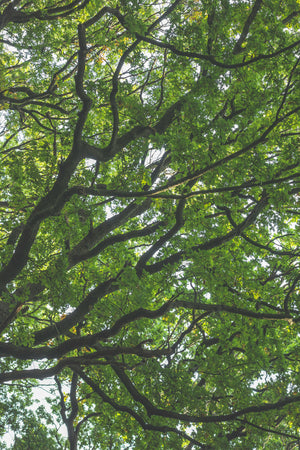
Common Questions
How long do oak trees live? Depending on species and site conditions, oaks can live anywhere from 100 to 300 years, with some white oaks reaching 500+ years.
What does an oak tree look like? Oaks typically have broad, spreading canopies, deeply ridged bark, and lobed or toothed leaves. Leaf shape and bark texture vary by species.
How to grow an oak tree from an acorn? Collect mature acorns in fall, remove caps, and plant in a container or directly in the ground 1–2 inches deep. Protect seedlings from animals and ensure consistent moisture.
How long does it take an oak tree to grow? Oaks grow slowly at first but become moderate to fast growers once established. Expect 1–2 feet of growth per year on average.
When and how to prune oak trees? Prune in winter while the tree is dormant. Avoid spring and summer pruning to prevent oak wilt. Remove dead or crossing limbs and shape young trees for strong structure.
What do the leaves of an oak tree look like? Leaf shapes vary by species. Red oaks tend to have pointed lobes; white oaks have rounded lobes. Some, like willow oak, have narrow, linear leaves.
Do oak trees need full sun? Yes. Oaks perform best in full sun with at least 6 hours of direct light per day. Limited sun can stunt growth and reduce vigor.
What type of soil do oak trees prefer? Oaks prefer well-drained, loamy soil but are adaptable. Avoid compacted or consistently wet soils unless using tolerant species like Quercus bicolor.
Conclusion
Oak trees are a cornerstone of the North American landscape—iconic, long-lived, and ecologically indispensable. Whether you're planting for shade, structure, wildlife, or legacy, there’s an oak species suited to the task. With careful site selection, early structural pruning, and a bit of patience, oaks reward gardeners with unmatched beauty and resilience for generations to come.

